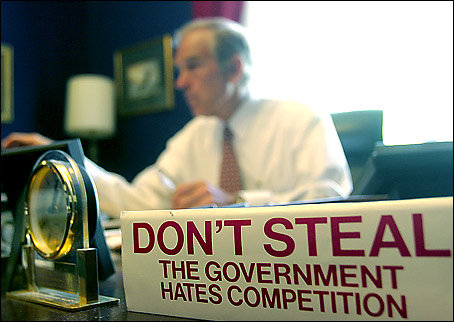 Last week, we looked at the “9-9-9” plan of Republican frontrunner Herman Cain. This week, we’ll examine the “Plan to Restore America,” presented by Silver Monthly favorite Ron Paul.
Last week, we looked at the “9-9-9” plan of Republican frontrunner Herman Cain. This week, we’ll examine the “Plan to Restore America,” presented by Silver Monthly favorite Ron Paul.
Spending
First, Dr. Paul promises to balance the federal budget by Year Three of his presidency. This isn’t just hollow political rhetoric, either: he shows which departments he’d cut and by how much. In Year One alone, he’d cut $1 trillion in federal spending and eliminate the Departments of Energy, Housing and Urban Development, Commerce, Interior, and Education. Paul also proposes to abolish the unpopular TSA, do away with all corporate subsidies, eliminate foreign aid, end the wars in Iraq and Afghanistan (and everywhere else Obama has invaded to limited fanfare), and return most other spending to 2006 levels. That all sounds pretty good, right?
Of course, Paul would need the support of Congress to accomplish this, and that might be a hard sell. Realistically, it’s difficult to imagine Paul actually winning the Republican nomination, but if he did, he might sweep a bunch of libertarian-minded Republicans into office along with him. Or, the current crop of unprincipled GOP incumbents might hop on the Ron Paul bandwagon and help him accomplish his goals in the name of their own reelections. More likely, however, is that even in the off chance that Paul were to win his party’s nomination, insiders from the party would work against his election – both covertly and openly. Nevertheless, indulging in the fantasy of his actual ascendancy to the nation’s highest office, Paul promises to use the power of the Veto, if need be, to cut $1 trillion in Year One and balance the budget by Year Three. It would be a struggle, but it could possibly be done.
Entitlements
On entitlements, Ron Paul promises to continue government spending on seniors and veterans, while allowing young people to opt out of the Social Security Ponzi Scheme. The federal government would reduce its hands-on involvement in redistribution by giving block grants to states to administer their own Medicare and welfare programs. Paul’s plan here would obviously be an improvement, but hardly the radical shakeup that America needs.
Government Waste
In his promise to cut government waste, Ron Paul succumbs to the gimmickry of other politicians. Paul, keep in mind, has always pointed out that the “cuts” promised by other politicians were insignificant: the earmarks, the “pork-barrel” projects, etc., don’t amount to a fraction of a percentage point in the overall federal budget. But when it is time for his presidential campaign, Paul – who has taken a congressional salary for most of the past thirty years – promises to accept just $39,336 per year for serving as president. Wow. That will save taxpayers $360,664 a year – about one-tenth of one cent per person in the U.S. He also talks about cutting congressional pay and benefits as if this would be a big deal. It wouldn’t be. Of course, unlike other politicians, Ron Paul does promise to make big cuts where they would count, such as in the military-industrial complex or so-called “defense” spending.
Taxes
Ron Paul is opposed to taxation on principle. This causes a bit of an ideological conundrum, however, because his salary has been funded by taxation for most of the past thirty years. As president, he promises to take a pay cut, but he will still be paid by the taxpayer. Paul says he likes the idea of a flat tax – “one that’s really flat, like zero” – but he makes no such bold promises in his Plan to Restore America. Instead, he promises to slash corporate taxes (but not personal ones), and end the so-called Death Tax. This would be good, but without similar tax cuts for working-class people, Paul runs the risk of being painted (very inaccurately) as a rich-man’s candidate. This threat is further exacerbated by the Paul campaign’s invocation of the “Bush” name, promising to “extend the Bush tax cuts.” Yikes. Can’t Ron Paul do better than that?
Regulation
Paul’s plan to slash regulations is perhaps his most bold, even though most people will find it rather unexciting. He says he will rescind ObamaCare, Sarbanes-Oxley, and Dodd-Frank (I wasn’t even sure what that last one was until I looked it up), and cancel all “onerous” regulations made by earlier Executive Orders. Here, it isn’t clear if he’s calling all regulations “onerous,” or if he’ll only cancel the ones he considers to be “onerous.” I’m hoping it’s the former.
Monetary Policy
Ron Paul then saves what would seem like the best for last: monetary policy. But here, he does not promise to (or even suggest that he might) abolish the Federal Reserve. Instead, he only calls for a “full audit.” Ho-hum. Allowing competing currencies, as he promises to do, would be nice, but so long as we’re required to pay up to 28% of our income back to the federal government in the form of Federal Reserve Notes, the competition will not be a fair one.
Conclusion
In conclusion, there can be no doubt that Ron Paul’s Plan to Restore America is better, more thoughtful, more radical, and still more practical than Herman Cain’s marketing gimmick of a “plan.” Ron Paul is a friend of liberty in general, and of gold and silver investors in particular. But pinning our hopes on any politician to “restore America” is problematic. In order for America to be restored to its past greatness, it will take the effort of millions of individuals, working in the pursuit of their own nonviolent self-interest. Instead of donating $100 to Ron Paul in a “money bomb,” a better plan is to buy $100 worth of silver coins. Ron Paul cannot give you your freedom – you need to take it for yourself.
